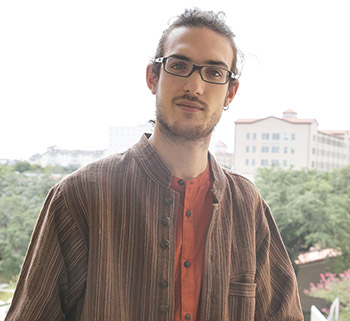
Mael LeNoc
It’s well-documented that family units were disrupted and displaced during the Holocaust – but just how affected were they, and were they able to reconvene following the war?
The spatio-temporal patterns of Jewish family arrests and separations during the Holocaust, specifically in Italy have intrigued Mael LeNoc, Ph.D. student in Geography at Texas State University, for some time. He’ll present his latest research – on the patterns of those arrests and deportations in Italy between September 1943 and February 1945, and how they vary from the displacements of individuals – in October at USC Shoah Foundation’s 2017 International Conference “Digital Approaches to Genocide Studies,” co-sponsored by the USC Mellon Digital Humanities Program.
The two-day conference, which will be held at the University of Southern California in Los Angeles, invited scholars from across the globe to converge and discuss the relationship between digital methodologies, practices, ethics and the nature of contemporary Holocaust and Genocide Studies.
LeNoc will contribute to the conference another of several discussions on the uses geographic information systems (GIS) for analyzing the Holocaust, innovatively answering the conference’s prompt: How can digital humanities shape, challenge or complement contemporary Holocaust and genocide studies, and vice versa?
“I wanted to be a part of this conference to hear about other digital approaches to the Holocaust and genocide studies, and to present my own work in hopes that it may inspire others,” LeNoc said. “I will be presenting results from my master’s thesis, regarding family arrests and separations during the Holocaust from a geographical perspective.”
In his research, LeNoc started from a massive GIS database of the individual victims of the Holocaust in Italy and devised a methodology to identify family groups from this list and to determine if and when members of these families were separated.
From there, LeNoc compared the experiences of both individuals and entire families with a focus on spatio-temporal patterns and the effect explanatory variables such as nationality, gender and age had on the degree and frequency of family separation and on an individual or family’s overall vulnerability to displacement.
LeNoc found that, although aggregate statistics did not show considerable differences between the experiences of individuals and families, significant spatio-temporal patterns arose, especially around the nationalities of both perpetrators and victims. The patterns also suggested a higher rate of vulnerability for families to round-ups, and that children and Jews born in Italy that were arrested in 1944 or 1945 were more likely to be separated than others.
LeNoc will address other significant points at the conference, which will feature over a dozen scholars presenting on a variety of subjects, from the netnography of digital autobiographical documentary to the usefulness of augmented reality technologies in sharing the memories of places of genocide.
“From others’ presentations, I hope to discover new techniques and approaches that I could use in my work later on,” LeNoc said.
The conference is the ideal place for LeNoc to learn about new digital techniques for research, the brainchild of the Institute that recently put out the New Dimensions in Testimony project – an emergent platform that allows those interested to interact with the projected image of a real Holocaust survivor, which will respond to questions in real time – and USC Mellon Digital Humanities Program, which exists as an intersection between the USC Dana and David Dornsife college of Letters, Arts and Sciences, the USC School of Cinematic Arts and USC Libraries.
As a scholar with the Holocaust Geographies Collaborative – a multi-institutional research group that uses mapping and geography to examine spaces and places of the Holocaust to shed new lights on history – LeNoc has visited USC Shoah Foundation once before, to examine its Visual History Archive, a collection of 54,000 digitized and fully searchable video testimonies from survivors and other eyewitness of the Holocaust, the Rwandan, Guatemalan and Armenian genocides and the Nanjing Massacre in China.
“The ability to easily access, consult and compare testimonies from the VHA is definitely one of the strengths of USC Shoah Foundation,” LeNoc said. “Testimonies are unique historical documents that permit us to develop qualitative research and to understand the victim’s perspective on the Holocaust.”
LeNoc will use notes from fellow researchers following his presentation to prepare his work for publication and to influence the topic of his dissertation, which he plans to center on family trajectories in France during the Holocaust.
Researcher Hannah Pollin-Galay of the University of Massachusetts, Amherst, will respond to his presentation.